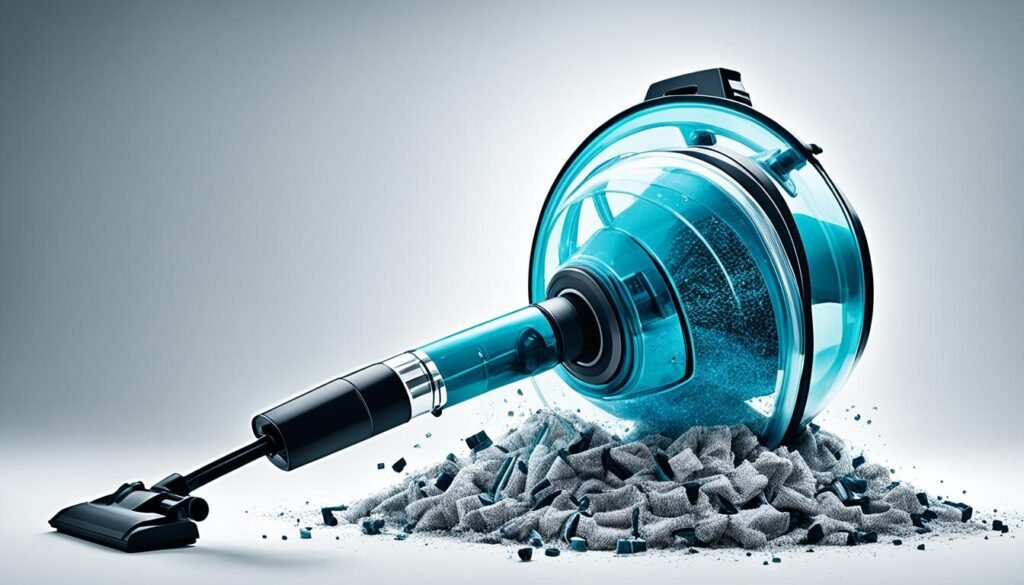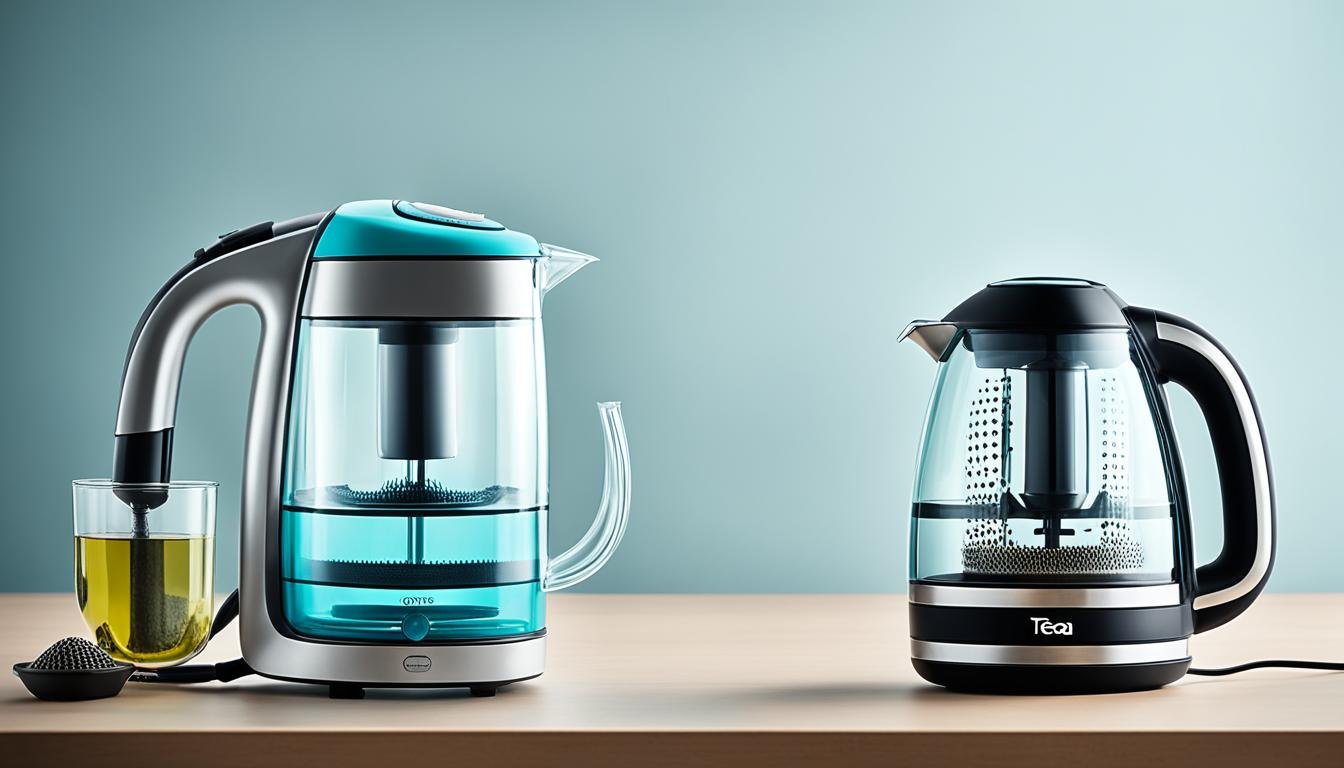Have you ever wondered what a vacuum cleaner and a tea strainer have in common? They may seem like unrelated household tools, but they actually share a common functionality – filters. Both vacuum cleaners and tea strainers rely on filters to perform their respective tasks effectively.
A vacuum cleaner uses filters to trap dust and dirt from the suctioned air, ensuring that your floors and carpets are left clean and free from debris. On the other hand, a tea strainer filters out tea leaves, allowing you to enjoy a smooth and refreshing cup of tea without any unwanted particles.
While their primary uses are different, vacuum cleaners and tea strainers both serve as essential cleaning tools in our everyday lives. They help us maintain cleanliness and hygiene, making our households more comfortable and pleasant to live in.
Key Takeaways:
- Vacuum cleaners and tea strainers both use filters to perform their tasks effectively.
- The filters in vacuum cleaners trap dust and dirt, while tea strainers filter out tea leaves.
- Both vacuum cleaners and tea strainers are common household tools with essential cleaning functionalities.
- Regular maintenance, including cleaning and replacement of filters, is necessary for optimal performance.
- Filters play a crucial role in maintaining cleanliness, reducing allergens, and preventing the release of harmful particles.
Why Vacuums Need Filters
Vacuum cleaner filters are essential components that play a crucial role in maintaining cleanliness and promoting a healthy living environment. These filters are designed to trap dust and dirt, preventing them from being released back into the air during the vacuuming process. Without effective filters, the suction power of the vacuum cleaner would be compromised, resulting in poor cleaning performance and the potential spread of allergens, bacteria, and other harmful particles.
By capturing dust and dirt particles, vacuum cleaner filters contribute to the overall cleanliness and hygiene of your home. When debris is sucked up into the vacuum, it passes through the filters, which act as barriers, preventing these particles from being expelled back into the surrounding air. This not only keeps your floors and surfaces cleaner but also helps to maintain a healthier indoor environment, especially for individuals with allergies or respiratory sensitivities.
Different types of vacuum cleaner filters work together to ensure optimal cleaning efficiency. Primary filters are the first line of defense, capturing larger particles such as pet hair, crumbs, and visible dirt. These filters are often made of foam or fibrous materials that can easily be cleaned or replaced. Secondary filters, on the other hand, have a more intricate design and are capable of capturing finer particles, including dust mites, pollen, and even bacteria. This second stage of filtration further enhances the overall cleanliness of your home and reduces potential allergens in the air.
It is important to note that not all vacuum cleaners have multiple filters or the same level of filtration. The type and number of filters present in a vacuum cleaner can vary depending on the make and model. Some vacuum cleaners may only have a single filter, while others may have a combination of primary and secondary filters to maximize cleaning efficiency.
Regular maintenance and cleaning of vacuum cleaner filters are crucial to ensure their effectiveness. Over time, filters can become clogged with dust and debris, restricting airflow and reducing suction power. Cleaning washable filters regularly can help prolong their lifespan and maintain the performance of your vacuum cleaner. For non-washable filters, it is important to follow the manufacturer’s recommendations for replacement intervals to ensure optimal filtration.
Benefits of Vacuum Cleaner Filters:
- Traps dust and dirt particles
- Improves indoor air quality
- Reduces allergens, bacteria, and other harmful particles
- Maintains suction power and cleaning efficiency
- Contributes to a cleaner and healthier home environment
By understanding the importance of vacuum cleaner filters and properly maintaining them, you can ensure that your vacuum cleaner continues to perform at its best, keeping your home clean and free from dust, allergens, and bacteria.
Types Of Vacuum Cleaner Filters
When it comes to vacuum cleaners, filters play a crucial role in maintaining optimal performance and ensuring clean air output. Different types of filters are used in vacuum cleaners, each designed to serve specific filtration purposes. Understanding these filter types will help you make an informed decision when choosing a vacuum cleaner that suits your needs.
Bagged Vacuum Cleaners
Bagged vacuum cleaners utilize dust bags as their primary filters. These bags effectively trap dirt, dust, and debris, preventing them from circulating back into the air. Bagged vacuum cleaners are known for their efficient filtration and easy disposal of collected debris. Simply remove the bag and replace it with a new one when full.
Bagless Vacuum Cleaners
In contrast, bagless vacuum cleaners do not require disposable dust bags. Instead, they employ pre-filters located before the dust canister. These pre-filters capture larger particles, preventing them from entering the canister. Bagless vacuum cleaners offer the convenience of not having to purchase and replace dust bags, making them cost-effective in the long run.
Cartridge Filters
Cartridge filters are circular in design and can act as either primary or secondary filters. They are commonly used in both bagged and bagless vacuum cleaners. Cartridge filters have a large surface area, enabling them to effectively trap dust and dirt particles. Depending on the vacuum cleaner model, cartridge filters may serve as the primary filter, collecting larger debris, or as secondary filters, capturing finer particles.
Foam Filters
Foam filters are washable filters typically found in vacuum cleaners as secondary filters. These filters function by removing allergens and fine dust particles from the air. Foam filters are excellent at capturing airborne pollutants, ensuring cleaner air output. Regular cleaning of foam filters is essential to maintain their effectiveness.
Disk Filters
Disk filters are primarily used as primary filters in small vacuum cleaners. These filters are designed to trap larger particles and prevent them from entering the vacuum cleaner’s motor or fan. Disk filters are commonly used in handheld or compact vacuum cleaners, where space is limited. They are easy to clean and maintain, making them ideal for smaller cleaning tasks.
Cyclonic Action
Some vacuum cleaners, particularly bagless models like the Dyson, utilize cyclonic action as their primary filtration method. Cyclonic action creates a strong centrifugal force that separates heavier particles from the air stream, depositing them into a separate chamber. This innovative filtration method effectively prevents clogging and maintains suction power, ensuring optimal cleaning performance.
Understanding the different types of vacuum cleaner filters allows you to choose a model that aligns with your cleaning needs and preferences. Whether you opt for a bagged or bagless vacuum cleaner, prioritize regular cleaning and maintenance of your filters to ensure the longevity and optimal performance of your appliance.

Cleaning Vacuum Cleaner Filters
Cleaning vacuum cleaner filters is crucial for maintaining their effectiveness and prolonging the lifespan of your vacuum cleaner. Regular maintenance ensures that the filters continue to trap dust, dirt, and allergens efficiently, resulting in cleaner air and better suction power.
For washable filters, start by gently rinsing them with cold running water until the water runs clear. Avoid using hot water as it can damage the filters. Be sure to consult the user manual to confirm if the filters are washable or not.
After washing, it’s important to allow the filters to dry completely before reinserting them into the vacuum cleaner. Drying precautions include leaving the filters in a well-ventilated area for approximately 24 hours. This helps prevent the growth of mold and unpleasant odors.
If your vacuum cleaner has non-washable filters, it’s recommended to replace them according to the manufacturer’s instructions. Filter replacement intervals can vary depending on the brand and model of your vacuum cleaner, so be sure to check the user manual or contact the manufacturer for guidance.
Remember, regular maintenance of your vacuum cleaner filters is essential for optimal performance and cleaner air in your home. By following proper cleaning and replacement procedures, you can ensure that your vacuum cleaner continues to work effectively and efficiently for years to come.
FAQ
How often should I clean the filters in my vacuum cleaner?
It is recommended to clean the filters in your vacuum cleaner every one to three months, depending on the frequency of use. Regular cleaning will help maintain optimal suction power and efficiency.
Can I wash the filters in my vacuum cleaner?
Not all filters are washable. Refer to your vacuum cleaner’s user manual to determine if the filters can be washed. If they are washable, gently rinse them under cold running water until the water runs clear. Allow the filters to air dry for approximately 24 hours before reinstalling them.
How do I know if it’s time to replace the filters in my vacuum cleaner?
If your vacuum cleaner has non-washable filters or if the filters are damaged or worn out, it is time to replace them. Additionally, if you notice a significant decrease in suction power or an increase in dust and debris escaping from the exhaust, it may be an indication that the filters need to be replaced.
Are there different types of filters used in vacuum cleaners?
Yes, there are various types of filters used in vacuum cleaners. Some common types include dust bags for bagged vacuum cleaners, pre-filters for bagless vacuum cleaners, cartridge filters, foam filters, and disk filters. Each type of filter has its own design and functionality.
Can vacuum cleaner filters capture allergens and pet dander?
Yes, certain filters used in vacuum cleaners, such as foam filters and high-efficiency secondary filters, are designed to trap allergens, pet dander, and fine dust particles. These filters help improve indoor air quality by reducing the circulation of airborne allergens, making them beneficial for those with allergies or asthma.





Leave a Reply